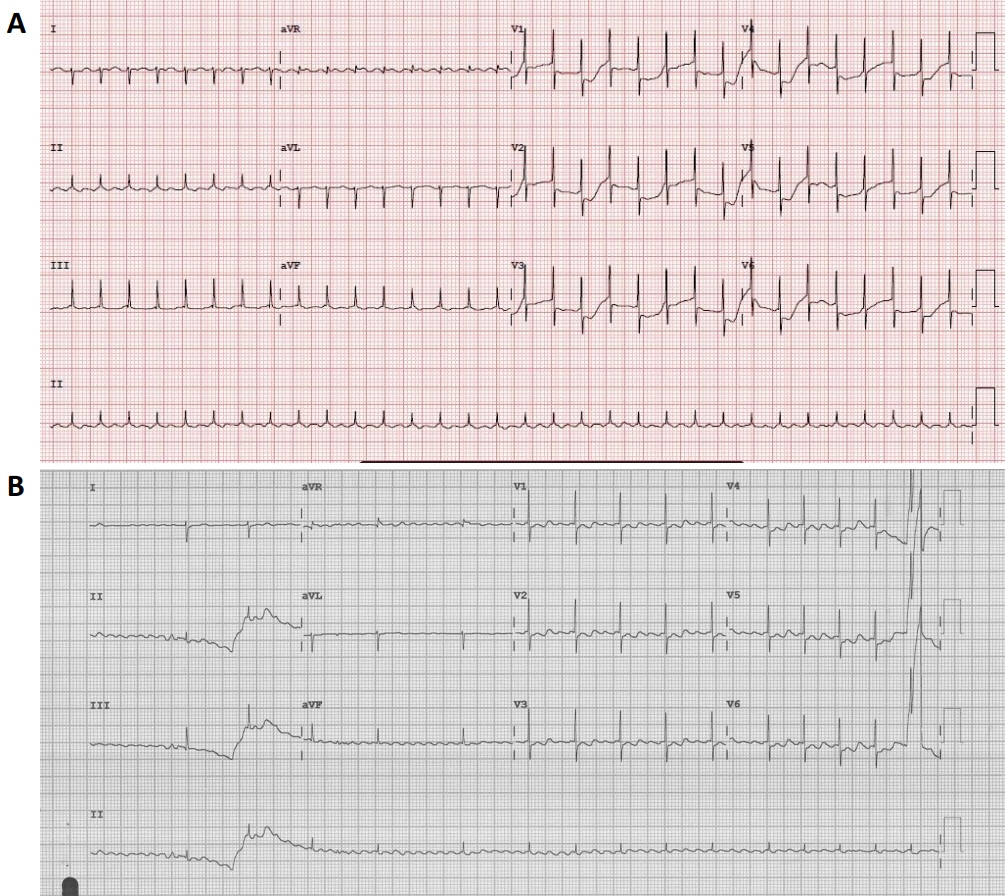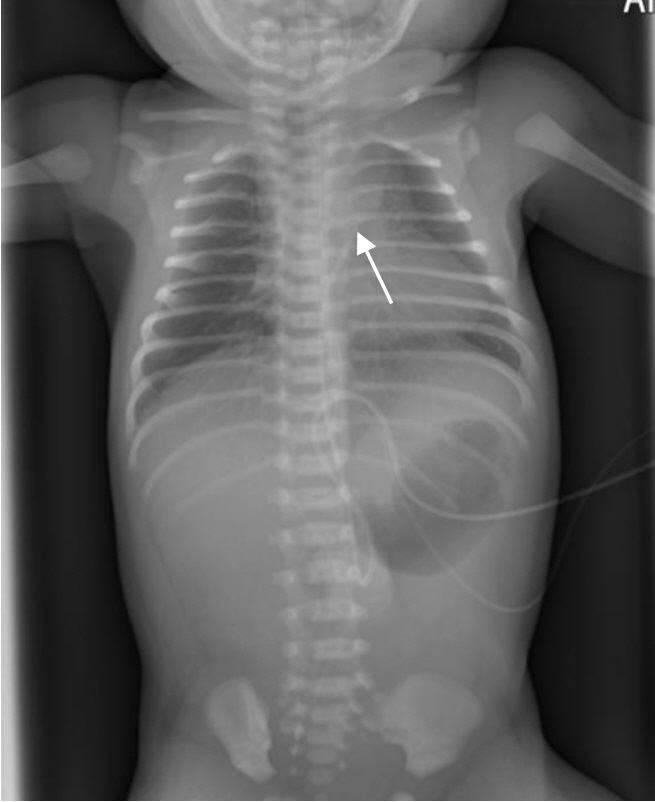Neonatal Med.
2022 Aug;29(3):97-104. 10.5385/nm.2022.29.3.97.
Neonatal Atrial Flutter: Clinical Characteristics of 14 Cases in a Single Center
- Affiliations
-
- 1Departments of Pediatrics, Ulsan University Hospital, University of Ulsan College of Medicine, Ulsan, Korea
- KMID: 2533091
- DOI: http://doi.org/10.5385/nm.2022.29.3.97
Abstract
- Purpose
Atrial flutter is an uncommon arrhythmia in the neonatal period. This study aimed to describe the cause and clinical course of atrial flutter in neonates.
Methods
The medical records of 14 patients diagnosed with atrial flutter at Ulsan University Hospital Neonatal Intensive Care Unit (NICU) between March 2008 and August 2020 were reviewed retrospectively.
Results
All 14 cases occurred on the first day of birth. Of these, two were term infants, and 12 were preterm infants. Causes of atrial flutter included three cases of the umbilical venous catheter misplacement, one with a diabetic mother, and one ivolving atrial flutter after an intravenous aminophylline injection. Thirteen patients had structurally normal hearts with no congenital heart diseases. The patient, born to a diabetic mother, had an atrial septal defect and ventricular hypertrophy. Adenosine was administered first to differentiate it from paroxysmal supraventricular tachycardia. Synchronized cardioversion was attempted in 11 patients, while one received it after an esmolol injection that failed to convert to sinus rhythm. One patient had a recurrence after the intrusion of a peripherally inserted central catheter; however, atrial flutter disappeared after repositioning it. No patient had a recurrence after discharge.
Conclusion
Neonatal atrial flutter is a rare tachyarrhythmia with the risk factors often unknown; however, it could occur in structural heart disease, mispositioning of the umbilical venous catheter, and if the mother has diabetes. During umbilical venous catheterization, clinicians should be cautious and ensure appropriate monitoring of infants in the NICU as it may cause complications.
Figure
Reference
-
1. Dubin AM. Arrhythmias in the newborn. NeoReviews. 2000; 1:e146–51.2. de Almeida MM, Tavares WG, Furtado MM, Fontenele MM. Neonatal atrial flutter after the insertion of an intracardiac umbilical venous catheter. Rev Paul Pediatr. 2016; 34:132–5.3. Lisowski LA, Verheijen PM, Benatar AA, Soyeur DJ, Stoutenbeek P, Brenner JI, et al. Atrial flutter in the perinatal age group: diag nosis, management and outcome. J Am Coll Cardiol. 2000; 35:771–7.4. Casey FA, McCrindle BW, Hamilton RM, Gow RM. Neonatal atrial flutter: significant early morbidity and excellent long-term prognosis. Am Heart J. 1997; 133:302–6.5. Texter KM, Kertesz NJ, Friedman RA, Fenrich AL Jr. Atrial flutter in infants. J Am Coll Cardiol. 2006; 48:1040–6.6. Wojtowicz-Marzec M, Wysokinska B, Respondek-Liberska M. Successful treatment of neonatal atrial flutter by synchronized cardioversion: case report and literature review. BMC Pediatr. 2020; 20:370.7. Ko JK, Kim SH, Bae EJ, Kang IS, Lee HJ. Atrial flutter conversion in infants and children using transesophageal atrial pacing. J Korean Pediatr Soc. 1994; 37:969–75.8. Oh KW, Lee KY, Kim JH, Kim JS. A case of atrial flutter after umbilical venous catheterization. Korean J Perinatol. 2012; 23:13–6.9. Lee MJ, Ahn SH, Kim JH, Kim SY, Ban JE. Intractable atrial flutter successfully treated with flecainide and propranolol in a premature infant. Ewha Med J. 2017; 40:140–2.10. Wacker-Gussmann A, Strasburger JF, Srinivasan S, Cuneo BF, Lutter W, Wakai RT. Fetal atrial flutter: electrophysiology and associations with rhythms involving an accessory pathway. J Am Heart Assoc. 2016; 5:e003673.11. Southall DP, Johnson AM, Shinebourne EA, Johnston PG, Vulliamy DG. Frequency and outcome of disorders of cardiac rhythm and conduction in a population of newborn infants. Pediatrics. 1981; 68:58–66.12. Turner CJ, Wren C. The epidemiology of arrhythmia in infants: a population-based study. J Paediatr Child Health. 2013; 49:278–81.13. Doi Y, Ueda K, Ogino K, Hayashi T, Takahashi A, Waki K, et al. Incidence of non-benign arrhythmia in neonatal intensive care unit: 18 years experience from a single center. J Arrhythm. 2022; 38:363–8.14. Dunnigan A, Benson W Jr, Benditt DG. Atrial flutter in infancy: diagnosis, clinical features, and treatment. Pediatrics. 1985; 75:725–9.15. Kothari DS, Skinner JR. Neonatal tachycardias: an update. Arch Dis Child Fetal Neonatal Ed. 2006; 91:F136–44.16. Kedziora P, Stasiak A. Atrial flutter-unique arrhythmia in neonatal population, presentation of 3 cases. Adv Neonatal Care. 2020; 20:487–94.17. Amer A, Broadbent RS, Edmonds L, Wheeler BJ. Central venous catheter-related tachycardia in the newborn: case report and literature review. Case Rep Med. 2016; 2016:6206358.18. Verheij G, Smits-Wintjens V, Rozendaal L, Blom N, Walther F, Lopriore E. Cardiac arrhythmias associated with umbilical venous catheterisation in neonates. BMJ Case Rep. 2009; 2009:bcr04.2009.1778.19. Sinha A, Fernandes CJ, Kim JJ, Fenrich AL Jr, Enciso J. Atrial flutter following placement of an umbilical venous catheter. Am J Perinatol. 2005; 22:275–7.20. Sivakumar S. Atrial flutter in preterm babies. Arch Dis Child Fetal Neonatal Ed. 2004; 89:F564.21. Gad A, Morelli P, Decristofaro J. Perinatal isolated atrial flutter associated with maternal cocaine and opiate use in a late preterm infant. J Matern Fetal Neonatal Med. 2010; 23:1062–5.22. Pike JI, Krishnan A, Kaltman J, Donofrio MT. Fetal and neonatal atrial arrhythmias: an association with maternal diabetes and neonatal macrosomia. Prenat Diagn. 2013; 33:1152–7.23. Tisdale JE, Chung MK, Campbell KB, Hammadah M, Joglar JA, Leclerc J, et al. Drug-induced arrhythmias: a scientific statement from the American Heart Association. Circulation. 2020; 142:e214–33.24. Yilmaz-Semerci S, Bornaun H, Kurnaz D, Cebeci B, Babayigit A, Buyukkale G, et al. Neonatal atrial flutter: three cases and review of the literature. Turk J Pediatr. 2018; 60:306–9.25. Ghandi Y, Alinejad S. A case report of neonatal atrial flutter with poor feeding and tachypnea. Iran J Neonatol. 2020; 11:92–6.
- Full Text Links
- Actions
-
Cited
- CITED
-
- Close
- Share
- Similar articles
-
- Management of Atrial Flutter
- A Case of Neonatal Atrial Flutter with Tuberous Sclerosis
- Atrial Flutter Conversion in Infants and Children Using Transesophageal Atrial Pacing
- A Case of Neonatal Atrial Flutter Treated by Propafenone after Fetal Echocardiographic Diagnosis
- Atrial Flutter in Neonates: A Report of Two Cases with Real-World Challenges




